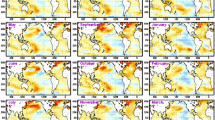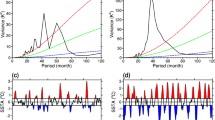Abstract
The impact of the warm SST bias in the Southeast Pacific (SEP) on the quality of seasonal and interannual variability and ENSO prediction in a coupled GCM is investigated. The reduction of this bias is achieved by means of empirical heat flux correction that is constant in time. It leads to a wide range of changes in the tropical Pacific climate including enhanced southeast trades, well-defined dry zone in the SEP, better simulation of the South Pacific Convergence Zone and stronger cross-equatorial asymmetry of the mean state in the eastern Pacific. As a result of the mean climate correction, significant improvements in the simulation of the seasonal cycle of the oceanic and atmospheric states are also observed both at the equator and basin-wide. Due to more realistic simulation of the seasonal evolution of the cold tongue, tropical convection and surface winds in the corrected version of the model, phase-lock of ENSO to the annual cycle looses its strong semi-annual component and becomes quite similar to the observed, although the amplitude of ENSO is reduced. Zonal wind stress response to the SST anomalies in the central-eastern Pacific also becomes more realistic. ENSO retrospective forecast experiments conducted with the directly coupled and the flux-corrected versions of the model demonstrate that deficiencies in the seasonal evolution of the cold tongue/Inter-Tropical Convergence Zone complex (that were largely due to the SEP bias in this model) and the related errors in the ENSO phase-lock to the annual cycle can seriously degrade ENSO prediction. By reducing these errors, ENSO predictive skill in the coupled model was substantially enhanced.
















Similar content being viewed by others
Notes
VAMOS—Variability of the American MOnsoonS, is a CLIVAR sponsored program.
Heat content denotes here potential temperature of the ocean averaged over the top 275 m.
References
AchutaRao K, Sperber K (2002) Simulation of the El Niño southern oscillation: results from the coupled model intercomparison project. Clim Dyn 19:191–209
An S-I, Wang B (2000) Interdecadal change of the structure of the ENSO mode and its impact on the ENSO frequency. J Clim 13:2044–2055
Capotondi A, Wittenberg A, Masina S (2006) Spatial and temporal structure of tropicalPacific interannual variability in 20th century coupled simulations. Ocean Model 15:274–298
Chen D, Cane MA, Zebiak SE, Cañizares R, Kaplan A (2000) Bias correction of an ocean–atmosphere coupled model. Geophys Res Lett 27. doi:10.1029/1999GL011078
Colbo K, Weller RA (2006) The variability and heat budget of the upper ocean under the Chile-Peru stratus. J Marine Res (in press)
da Silva AM, Young CC, Levitus S (1994) Atlas of Surface Marine Data 1994, NOAA Atlas NESDIS 6–10, U.S. Department of Commerce, NOAA, NESDIS
Davey MK, et al (2002) STOIC: A study of coupled model climatology and variability in tropical ocean regions. Clim Dyn 18:403–420
Deser C, Capotondi A, Saravanan R, Phillips AS (2006) Tropical Pacific and Atlantic climate variability in CCSM3. J Clim 19:2451–2481
Guilyardi E (2006) El Niño-mean-state-seasonal cycle interactions in a multi-model ensemble. Clim Dyn 26:329–348
Guldberg A, Kaas E, Déqué M, Yang S, Vester Thorsen S (2005) Reduction of systematic errors by empirical model correction: impact on seasonal prediction skill. Tellus 57A:575–588
Huang B, Kinter III JL (1997) A global ocean data analysis for 1986–1992. COLA Tech Rep 38, 62pp. http://grads.iges.org/reps/rep38/colarep38.html
Huang B, Kinter JL III, Schopf PS (1999) An ocean data assimilation system with intermittent analyses and continuous model error correction. COLA Tech Rep 72, 60pp. Available at Center for Ocean–Land–Atmosphere Studies, 4041 Powder Mill Road, Suite 302, Calverton, MD 20705 USA
Huang B, Schneider EK (1995) The response of an ocean general circulation model to surface wind stress produced by an atmospheric general circulation model. Mon Wea Rev 123:3059–3085
Huang B, Schopf PS, Shukla J (2004) Intrinsic ocean–atmosphere variability of the tropical Atlantic Ocean. J Clim 17:2058–2077
Hu Z-Z, Huang B (2007) The predictive skill and the most predictable pattern in the Tropical Atlantic: The effect of ENSO. Mon Wea Rev 135:1786–1806
Joseph R, Nigam S (2006) ENSO evolution and teleconnections in IPCC’s twentieth-century climate simulations: realistic representation? J Clim 19:4360–4377
Kalnay E, Kanamitsu M, Kistler RE, Collins W, Deaven D, Gandin L, Iredell M, Saha S, White G, Woollen J, Zhu Y, Chelliah M, Ebisuzaki W, Higgins W, Janowiak J, Mo KC, Ropelewski C, Wang J, Leetmaa A, Reynolds R, Jenne R, Joseph D (1996) The NCEP/NCAR 40-year reanalysis project. Bull Amer Met Soc 77:437–471
Kiehl JT, Gent PR (2004) The community climate system model, Version 2. J Clim 17:3666–3682
Kirtman BP (1997) Oceanic Rossby wave dynamics and the ENSO period in a coupled model. J Clim 10:1690–1704
Klein SA, Hartmann DL (1993) The seasonal cycle of low stratiform clouds. J Clim 6:1587–1606
Large WG, Danabasoglu G (2006) Attribution and impacts of upper-ocean biases in CCSM3. J Clim 19:2325–2346
Latif M, Sperber K (2001) ENSIP: the El-Niño simulation intercomparison project. Clim Dyn 18:255–276
Li T, Hogan TF (1999) The role of the annual-mean climate on seasonal and interannual variability of the Tropical Pacific in a coupled GCM. J Clim 12:780–792
Li T, Philander SGH (1996) On the annual cycle of the eastern equatorial Pacific. J Clim 9:1986–1998
Lietzke CE, Deser C, Vonder Haar TH (2001) Evolutionary structure of the eastern Pacific double ITCZ based on satellite moisture profile retrievals. J Clim 14:743–751
Ma C-C, Mechoso CR, Robertson AW, Arakawa A (1996) Peruvian stratus clouds and tropical Pacific circulation: a coupled ocean–atmosphere GCM study. J Clim 9:1635–1645
Manabe S, Stouffer RJ, Spelman MJ, Bryan K (1991) Transient responses of a coupled ocean–atmosphere model to gradual changes of atmospheric CO2. Part I: Annual mean response. J Clim 4:785–818
Manganello JV, Huang B (2006) The influence of the mean state on the annual cycle and ENSO variability: a sensitivity experiment of a coupled GCM. COLA Tech Rep 218, 60pp. ftp://grads.iges.org/pub/ctr/ctr_218.pdf
McPhaden MJ (2002) Mixed layer temperature balance on intraseasonal timescales in the equatorial Pacific Ocean. J Clim 15:2632–2647
Mechoso CR, et al (1995) The seasonal cycle over the tropical Pacific in coupled ocean–atmosphere general circulation models. Mon Wea Rev 123:2825–2838
Meehl GA, Covey C, McAvaney B, Latif M, Souffer RJ (2005) Overview of the coupled model intercomparison project. Bull Am Meteorol Soc 86:89–93
Mitchell TP, Wallace JM (1992) The annual cycle in equatorial convection and sea surface temperature. J Clim 5:1140–1156
Murphy JM (1995) Transient response of the Hadley Centre coupled ocean–atmosphere model to increasing carbon dioxide. Part I: Control climate and flux adjustment. J Clim 8:36–56
Neelin JD, Dijkstra HA (1995) Ocean–atmosphere interaction and the tropical climatology. Part I: The dangers of flux correction. J Clim 8:1325–1342
Niiler PP (ed) (1981) Tropical Pacific upper ocean heat and mass budgets. A research program outline, special publication, 56pp, Hawaii Inst of Geophys, Honolulu
Penven P, Echevin V, Pasapera J, Colas F, Tam J (2005) Average circulation, seasonal cycle and mesoscale dynamics of the Peru Current System: a modeling approach. J Geophys Res 110. doi:10.1029/2005JC002945
Picaut J, Ioualalen M, Menkes C, Delcroix T, McPhaden MJ (1996) Mechanism of the zonal displacements of the Pacific Warm Pool: implications for ENSO. Science 274:1486–1489
Rasmusson E, Carpenter T (1982) Variations in tropical sea surface temperature and surface wind fields associated with the Southern Oscillation/El Niño. Mon Wea Rev 110:354–384
Saha S, Nadiga S, Thiaw C, Wang J, Wang W, Zhang Q, Van den Dool HM, Pan H-L, Moorthi S, Behringer D, Stokes D, Peña M, Lord S, White G, Ebisuzaki W, Peng P, Xie P (2006) The NCEP climate forecast system. J Clim 19:3483–3517
Sato N, Sellers PJ, Randall DA, Schneider EK, Shukla J, Kinter JL III, Hou Y-T, Albertazzi E (1989) Effects of implementing the simple biosphere model (SiB) in a general circulation model. J Atmos Sci 46:2757–2782
Sausen R, Barthel K, Hasselmann K (1988) Coupled ocean–atmosphere models with flux correction. Clim Dyn 2:145–163
Schneider EK, Zhu Z, Giese BS, Huang B, Kirtman BP, Shukla J, Carton JA (1997) Annual cycle and ENSO in a coupled ocean–atmosphere model. Mon Wea Rev 125:680–702
Schneider EK (2002) Understanding differences between the equatorial Pacific as simulated by two coupled GCMs. J Clim 15:449–469
Schneider EK, DeWitt DG, Rosati A, Kirtman BP, Ji L, Tribbia JJ (2003) Retrospective ENSO forecasts: sensitivity to atmospheric model and ocean resolution. J Clim 131:3038–3060
Schopf PS, Loughe A (1995) A reduced-gravity isopycnal ocean model: hindcasts of El Niño. Mon Wea Rev 123:2839–2863
Smith TM, Reynolds RW, Livezey RE, Stokes DC (1996) Reconstruction of historical sea surface temperatures using empirical orthogonal functions. J Clim 9:1403–1420
Spencer H, Sutton R, Slingo JM (2007) El Niño in a coupled climate model: sensitivity to changes in mean state induced by heat flux and wind stress corrections. J Clim 20:2273–2298
Swenson MS, Hansen DV (1999) Tropical Pacific ocean mixed layer heat budget: the Pacific cold tongue. J Clim 29:69–81
Trenberth K (1997) The definition of El Niño. Bull Amer Met Soc 78:2771–2777
Turner AG, Inness PM, Slingo JM (2005) The role of the basic state in ENSO-monsoon relationship and implications for predictability. Q J R Meteorol Soc 131:781–804
Uppala SM, Kållberg PW, Simmons AJ, Andrae U, da Costa Bechtold V, Fiorino M, Gibson JK, Haseler J, Hernandez A, Kelly GA, Li X, Onogi K, Saarinen S, Sokka N, Allan RP, Andersson E, Arpe K, Balmaseda MA, Beljaars ACM, van de Berg L, Bidlot J, Bormann N, Caires S, Chevallier F, Dethof A, Dragosavac M, Fisher M, Fuentes M, Hagemann S, Hólm E, Hoskins BJ, Isaksen L, Janssen PAEM, Jenne R, McNally AP, Mahfouf J-F, Morcrette J-J, Rayner NA, Saunders RW, Simon P, Sterl A, Trenberth KE, Untch A, Vasiljevic D, Viterbo P, Woollen J (2005) The ERA-40 re-analysis. Quart J R Meteorol Soc 131:2961–3012
van Oldenborgh GJ, Philip SY, Collins M (2005) El Niño in a changing climate: a multi-model study. Ocean Science 1:81–95
Wang W, McPhaden MJ (2000) The surface-layer heat balance in the equatorial Pacific Ocean. Part II: Interannual variability. J Phys Oceanogr 30:2989–3008
Wittenberg AT, Rosati A, Lau N-C, Ploshay JJ (2006) GFDL’s CM2 global coupled climate models. Part III: Tropical Pacific climate and ENSO. J Clim 19:698–722
Xie P, Arkin P (1996) Analysis of global monthly precipitation using gauge observations, satellite estimates, and numerical model predictions. J Clim 9:840–858
Xie S-P (1994a) The maintenance of an equatorially asymmetric state in a hybrid coupled GCM. J Atmos Sci 51:2602–2612
Xie S-P (1994b) On the genesis of the equatorial annual cycle. J Clim 7:2008–2013
Xie S-P (2005) The shape of continents, air–sea interaction, and the rising branch of the Hadley Circulation. In: Diaz HF, Bradley RS (eds) The Hadley Circulation: present, past and future. Kluwer, Dordrecht, pp 121–152
Xue Y, Sellers PJ, Kinter JL III, Shukla J (1991) A simplified biosphere model for global climate studies. J Clim 4:345–364
Yang X-Q, Anderson JL (2000) Correction of systematic errors in coupled GCM forecasts. J Clim 13:2072–2085
Yu Z, Schopf PS (1997) Vertical eddy mixing in the tropical upper ocean: its influence on zonal currents. J Phys Oceanogr 27:1447–1458
Zhang C (2001) Double ITCZs. J Geophys Res 106:11785–11792
Acknowledgments
This study is sponsored by the NSF grant NSF 0332910, the NOAA grant NA04OAR4310034 and the NASA grants NNG04GG46G and NNG06GB54G. Huang is also supported by a research grant from the NOAA CVP Program (NA07OAR4310310). We would like to thank Professor J. Shukla for his support of this project. We would also like to thank Barry Klinger and Vasubandhu Misra for discussions, Professors Ben Kirtman and David Straus for suggestions on the manuscript and two anonymous reviewers for their useful comments.
Author information
Authors and Affiliations
Corresponding author
Rights and permissions
About this article
Cite this article
Manganello, J.V., Huang, B. The influence of systematic errors in the Southeast Pacific on ENSO variability and prediction in a coupled GCM. Clim Dyn 32, 1015–1034 (2009). https://doi.org/10.1007/s00382-008-0407-5
Received:
Accepted:
Published:
Issue Date:
DOI: https://doi.org/10.1007/s00382-008-0407-5




